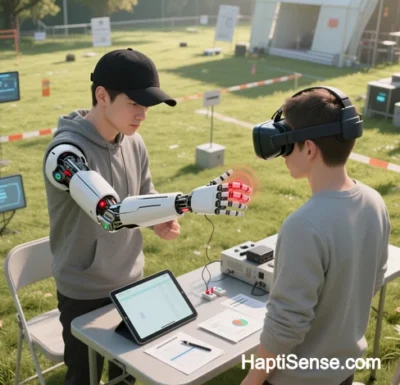
Hapti Sense: Innovations in Haptic Feedback and Sensory Enhancement Technologies
2025 Technological Landscape and Future Perspectives
Core Technological Breakthroughs: From Mechanical Vibration to Multimodal Sensory Enhancement
Flexible Materials and Wearable Innovations
- Skin-integrated haptic interfaces: Ultrathin electronic skins (<50 μm) enable wireless 3D perception of pressure, temperature, and texture with micron-level deformation control (e.g., MIT’s biomimetic haptic film).
- Modular haptic gloves: Combine pneumatic actuators and electrostatic friction to simulate grip force (0.1–10N) and surface roughness (Ra 0.8–25μm) across 12 independent modules (latency <20 ms).
- Hybrid electrotactile-vibration feedback: Electrotactile technology stimulates cutaneous receptors via microcurrents, enabling precise feedback without mechanical vibration (e.g., Tactai’s electrostatic screens with 40 points/cm² resolution).
Neurosensory Modeling
- Haptic encoding algorithms: Deep learning-driven models (e.g., NeuroHaptics framework) map physical stimuli to cortical activation patterns with >90% accuracy.
- Multimodal sensory fusion: Closed-loop systems integrating EMG and haptic feedback (e.g., ETH Zurich’s HapticProsthesis) allow amputees to perceive pressure and texture simultaneously.
Environmental Interaction Technologies
- Contactless haptic fields: Ultrasound arrays (Ultrahaptics 2.0) project programmable tactile hotspots in 3D space (e.g., raindrop simulation with ±2mm positional accuracy).
- Chemical haptics: Microfluidic chips release compounds (menthol, capsaicin) to induce thermal/pain sensations, enabling cross-modal sensory augmentation.
Applications: From Consumer Electronics to Life Sciences
Healthcare and Rehabilitation
- Remote surgical navigation: 7-DOF haptic robotic arms (e.g., MediTouch) distinguish tissue stiffness (e.g., liver vs. tumor at 0.3N±0.05 force thresholds) via multi-frequency vibration.
- Neuromotor recovery: BCI-driven haptic gloves (e.g., RehabGlove) enhance post-stroke motor cortex plasticity, improving recovery efficiency by 40%.
Consumer Electronics and VR/AR
- XR haptic ecosystems: Meta Quest Pro 2’s full-body suit integrates 160 haptic nodes and thermal modules to simulate material conductivity (e.g., 15°C difference for copper vs. wood).
- Smart cockpit interfaces: BMW iDrive 9.0’s 3D touchscreens mimic physical buttons via localized stiffness modulation (0.7N click force, 0.2mm travel), reducing misinputs by 75%.
Industrial and Robotics
- Precision assembly: ABB YuMi robots with 6-axis force sensors (±0.02N accuracy) and AR-guided tactile projection enable micron-level part alignment.
- Hazard detection: Boston Dynamics’ Spot robots use haptic-thermal probes to identify material degradation (e.g., >200Hz vibration shifts in corroded pipes).
Future Directions: Next-Generation Haptic Technologies
Neural Interface Advancements
- Cortical haptic interfaces: Neuralink’s N3 chip aims for bidirectional communication between tactile signals and the somatosensory cortex, bypassing skin receptors.
- Emotive haptic design: Affective computing protocols (e.g., Haptic Emotion Markup Language) trigger psychological states via tailored vibration patterns.
Environmental Interaction Networks
- Haptic IoT: Distributed sensor networks (e.g., Tesla’s tactile road systems) monitor real-time road conditions, relaying risks via in-car haptic seats.
- Metaverse haptic standards: IEEE P2048.9 draft standardizes cross-platform tactile data formats for virtual object properties (texture, weight, elasticity).
Sustainability and Ethics
- Biodegradable actuators: Silk protein-based devices (e.g., SilkHaptics) reduce carbon footprint by 80% while enabling natural degradation.
- Privacy protection: Differential privacy algorithms anonymize haptic data streams to prevent biometric identification.
Market Outlook and Industry Ecosystem
- Growth projections: Global haptics market to exceed $32B by 2030 (22.3% CAGR), driven by healthcare and automotive sectors (>60% share). Electrotactile tech leads with 35% CAGR.
- Competitive landscape: 180% surge in patents (2020–2025), dominated by Apple (haptic engines), Meta (pneumatic actuation), and Sony (ultrasound focusing).
- Collaborative ecosystems: Open Haptics Alliance unites 50+ firms to develop open-source middleware (supports Unity/Unreal plugins).
Conclusion and Vision
Haptic technology is transitioning from basic vibrations to neuromorphic sensory augmentation. Key 2025 milestones include:
- Neural realism: Clinically stable brain-computer haptic interfaces (>1-year durability).
- Metaverse infrastructure: Commercial haptic cloud platforms supporting million-user tactile data streams.
- Ethical governance: WHO’s Guidelines for Biosafety in Haptic Tech to regulate neuroenhancement devices.
Over the next decade, haptics will redefine human-digital interaction, potentially surpassing vision and audition as the core interface paradigm. Developers must balance precision with neuroplasticity risks and societal equity to ensure inclusive technological progress.
Data sourced from publicly available references. For collaborations, contact: chuanchuan810@gmail.com.







HaptiSense(触觉感知技术)在医疗领域的应用
1. 手术模拟与培训
通过触觉反馈设备(如力反馈手套或手术机器人)模拟真实手术中的组织触感,帮助医生进行无风险训练。
案例:达芬奇手术机器人系统整合触觉反馈,提升微创手术的精准度。
2. 康复治疗与假肢控制
仿生假肢集成触觉传感器,将压力、温度信号转化为电刺激,帮助截肢患者恢复触觉感知。
康复机器人(如外骨骼)通过实时力反馈辅助患者进行运动训练。
3. 远程手术与医疗机器人
5G网络下,医生通过触觉反馈远程操控手术器械,感知患者体内组织的阻力或弹性。
4. 诊断辅助
触觉传感器用于检测组织硬度差异(如肿瘤边界识别),辅助早期癌症诊断。
5. 患者交互与心理治疗
虚拟现实(VR)结合触觉反馈,用于疼痛管理或心理治疗(如焦虑症暴露疗法)。
技术挑战:延迟问题(远程手术)、高精度传感器成本。